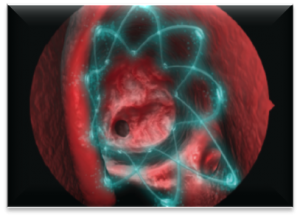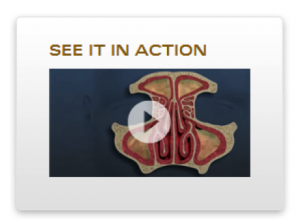There are several ways to treat sinus problems, depending on the exact type and extent of the problem.
Medical therapy
Therapy for bacterial sinusitis should include an appropriate antibiotic. An oral steroid or prescription nasal steroid spray is often used to decreased inflammation to make the antibiotics more effective. Sometimes an oral or nasal decongestant may be helpful to relieve congestion, although you should avoid prolonged use of nonprescription nasal sprays.
Saline irrigation of the nasal cavity is a vital part of treating sinusitis. It works by flushing infected mucous out of the nasal cavity. It helps prepare the nasal cavity for topical medication and can help relieve sinus discomfort.
Source: NeilMed Pharmaceuticals
Antibiotics can also be aerosolized by a nebulizer into the nose and sinuses. Nebulization produces very small particles that can penetrate the sinus passageways. Medications are directly delivered to the infected sinus tissue and/or decrease the bacteria located in the nose. This may allow for the antibiotics to be delivered in higher concentrations than medications taken orally or intravenously.
A nebulized or topical antibiotic is sometimes used to treat more complicated cases or if oral antibiotics have not been effective. In cases of chronic or recurrent sinusitis, a more intensive and longer antibiotic regimen may be prescribed.
Sinus surgery
Surgery and other sinus procedures are considered when medical treatment fails or to remove physical obstructions that may contribute to sinusitis. The type of procedure is chosen to best suit the patient and the disease.
Balloon sinus dilation
Balloon sinus dilation, sometimes referred to as Balloon Sinuplasty™ is a relatively new, minimally invasive procedure that reopens the sinus pathways and restores drainage to deliver immediate and long lasting relief to recurrent and chronic sinusitis sufferers.
Functional endoscopic sinus surgery (FESS)
FESS is recommended for certain types of sinus disease, usually more severe disease and/or polyp formation. With the endoscope, we can look directly into the nose, while at the same time, removing diseased tissue and polyps and clearing the narrow channels between the sinuses. Frequently, computer guided navigation is used to make surgery more complete and safe.
Propel Sinus Stent
 PROPEL is a relatively new technology that can be used as an adjunt to one of the above procedures. It is clinically proven to improve surgical outcomes for chronic sinusitis sufferers.
PROPEL is a relatively new technology that can be used as an adjunt to one of the above procedures. It is clinically proven to improve surgical outcomes for chronic sinusitis sufferers.
When placed in the sinus following surgery, PROPEL decreases scarring and inflammation, reducing the need for additional surgical procedures as well as oral steroids and their potential side effects1.
The spring-like PROPEL implant props open the ethmoid sinus to maintain the surgical opening, delivers an anti-inflammatory medication directly to the sinus lining, and then dissolves, avoiding the need for removal.
Before surgery, be sure that you have realistic expectations for the results, recovery, and postoperative care. Sinus surgery is not an ‘end result’. But rather, it is part of the treatment process. It allows for improved airflow and mucus flow which enables better drainage of the sinuses and facilitation of more effective topical drug penetration into the sinuses. Good results require not only good surgical techniques, but a cooperative effort between the patient and physician throughout the healing process. It is equally important for patients to follow pre- and postoperative instructions.
Schedule an Appointment
If you would like to schedule an appointment with the Tennessee Sinus and Snoring Center please click on the link below.

